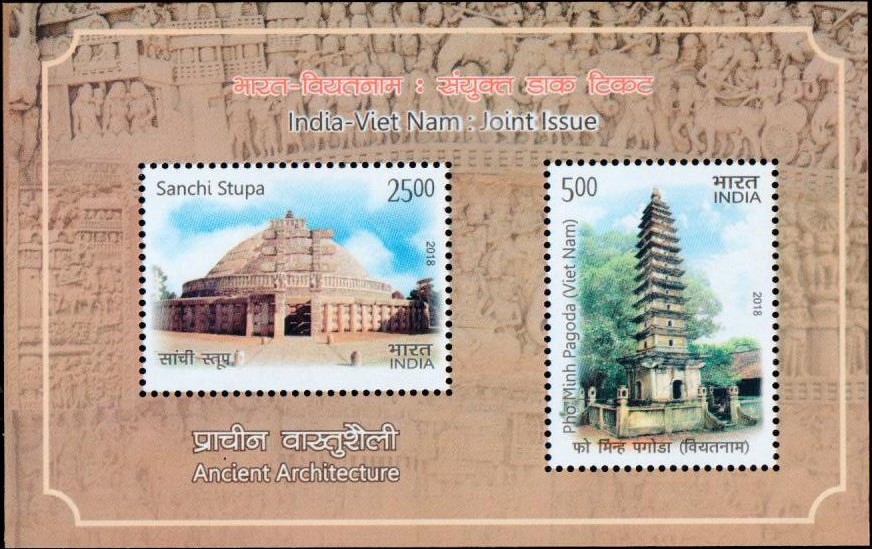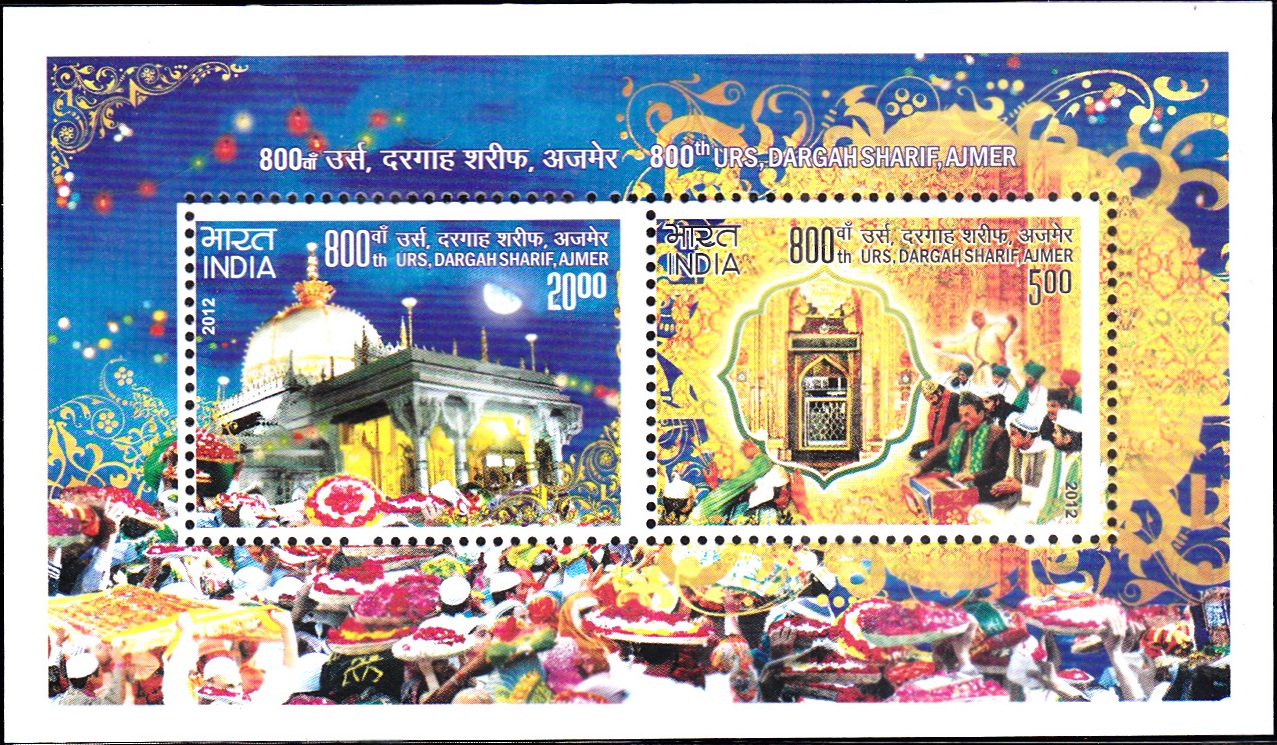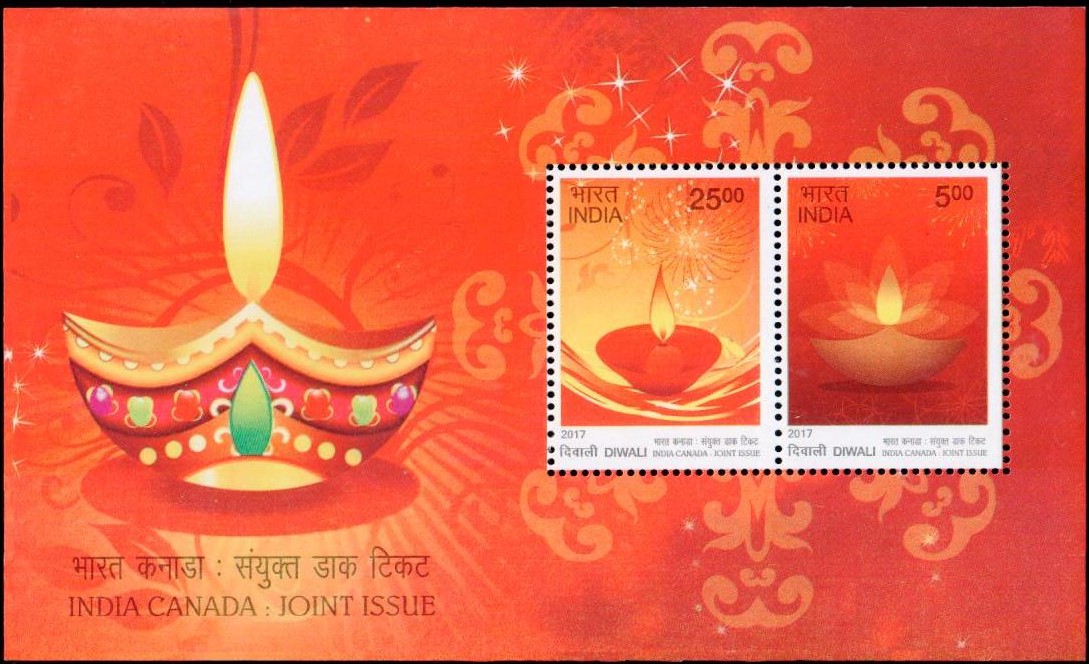
India-Viet Nam : Joint Issue
Complete set of 2 nos. of commemorative postage stamps on 2000 years of civilizational relationship between India and Viet Nam : Ancient Architectures : Sanchi Stupa of India and Pho Minh Pagoda of Vietnam :


 Issued by India
Issued by India
Issued on Jan 25, 2018
Issued for : Department of Posts is pleased to release a set of two Commemorative Postage Stamps between India and Viet Nam on the theme Ancient Architecture featuring ‘Sanchi Stupa’ of India and ‘Pho Minh Pagoda’ of Viet Nam.
Credits :
Stamp/Miniature Sheet/First Day Cover/Brochure : Shri Brahm Prakash
Cancellation Cachet : Smt. Alka Sharma
Type : Miniature Sheet, Mint Condition
Colour : Multi Colour
Denomination : 2500 & 500 Paise
Stamps Printed : 0.5 million each
Miniature Sheet Printed : 103500
Printing Process : Wet Offset
Printer : Security Printing Press, Hyderabad
About :
- The civilizational relationship between India and Viet Nam spans over 2000 years. Monks, traders and people from both countries have interacted over centuries. The intense cultural exchanges have enriched the cultural diversity of the region. India and Viet Nam enjoy good relations and have established bilateral cooperation mechanisms. The relations between the two countries are marked by strong trust, mutual understanding and convergence of views on various international issues and the regional security situation in Asia.
- In recent times, political contacts have strengthened as reflected in several high-level visits by leaders from both sides. Trade and economic linkages continue to grow. Viet Nam is an important regional partner in South East Asia. India and Viet Nam closely cooperate in various regional forums such as ASEAN, East Asia Summit, Mekong Ganga Cooperation, Asia Europe Meeting (ASEM) besides UN and WTO.
- India and Viet Nam have emphasized that enhancing bilateral economic engagement is a strategic objective. The bilateral trade is growing at a healthy pace.
- In 2017, the two countries have celebrated the 45th Anniversary of the establishment of diplomatic relations and the 10th Anniversary of Strategic Partnership. The theme for the joint issue is “Ancient Architecture”, depicting “Sanchi Stupa” in the Indian stamp and “Pho Minh Pagoda” in the Viet Nam stamp. The Sanchi Stupa and the Pho Minh Pagoda are architectural landmarks of their respective countries and are tied by the common thread of Buddhism.
- Sanchi Stupa:
- The Great Stupa at Sanchi is one of the most important Buddhist monuments. Located at Sanchi town, Madhya Pradesh, India, this Stupa is the oldest stone structure in India that was built during the Mauryan period. Originally commissioned in the third century B.C. by Emperor Ashok, this huge hemispherical dome with a height of 54.0 ft consists of a central chamber where the relics of Lord Buddha are placed. Four ornamental gateways facing four directions and a balustrade surrounding the Stupa were later added in the first century B.C. Enlisted as a UNESCO World Heritage Site since 1989, it is counted among the best conserved ancient Stupas of central India.
- The present hemispherical edifice is double in diameter of the original brick structure built by Ashoka, consisting of the relics of Lord Buddha. A chatra that is an umbrella like structure made of stone crowned the hemispherical brick structure that was surrounded by a wooden railing. A sandstone pillar, inscribed with Edict by Ashoka as also with ornate spiral Brahmi characters from the Gupta period resembling conch shells referred as ‘Shankhalipi’ or ‘shell-script’ by scholars, was erected in the site. While the lower portion of it is still grounded, the upper portions are kept under a canopy. During the Shunga dynasty, expansion of the Stupa, nearly double its original size with a more flattened dome was undertaken using stone slabs that entirely covered the actual brick Stupa. Three superimposed umbrella-like structures were built to crown the dome. It symbolized the Wheel of Law or ‘dharma’. A high rounded drum that can be reached through a double staircase became the seat of the dome enabling one to circumambulate the sacred dome.
- Pho Minh Pagoda:
- Pho Minh Pagoda is located 4 km north of Nam Dinh City and 94 km south of Hanoi, the Capital city. The pagoda was originally built during the Ly Dynasty of Viet Nam and later expanded in 1262 during the Tran Dynasty. It was a place for high-ranking mandarins and the aristocracy of the Tran Royal Court to worship and lead their religious life.
- The architecture and decorations of the pagoda are characteristics of the Tran Dynasty’s times: lotus flower pond, lotus-flower decorations at the foot of the pillars, the Tran-styled dragon sculptures, the stone candle holders. Specially, a 13 story-tower named Pho Minh Tower in the shape of a lotus, 19 meters high, was built just in front yard of the pagoda in 1305. The base and the tower’s first floor were constructed with flagstones and the upper floors were built with bricks. On top of the tower, there is a gourd-shaped decoration which is kind of talisman to catch the elite energy from the universe. The tower is believed to connect the Earth and the Universe. Pho Minh Pagoda is mostly visited by the Vietnamese Buddhist Pilgrims and tourists, especially in festival times.
- Text : Based on the information received from Ministry of External Affairs and Viet Nam Post.








Very informative
[…] first day cover depicts a column of Sanchi Stupa gate (circa 1st century B.C.) showing an assembly of elected representatives of the […]